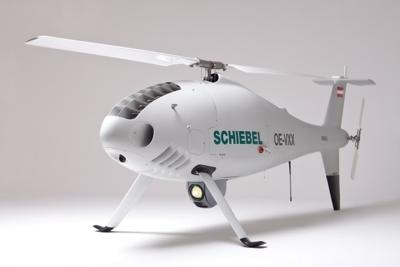Thu, Aug 28, 2014
Flying From Ship-Borne Migrant Offshore Aid Station
As part of the Migrant Offshore Aid Station operation the Schiebel Camcopter S-100 UAS (Unmanned Air System) is helping to save the lives of refugees in the Mediterranean Sea.

Desperate people fleeing conflict, economic desperation and violence in their homeland look towards Europe as a safe haven. They travel by all means possible for days or weeks on end to get to countries of transit from which they will sail out in makeshift sea craft. The lucky ones reach Europe where they can claim asylum, the unlucky ones perish.
MOAS was founded to take action to prevent such tragedies in the future and initiated Operation Phoenix where the Camcopter S-100 plays a vital role. A ship-borne aid station, named Phoenix, was made available to support refugee vessels in need. Phoenix has two 18-foot rigid inflatable boats on board that respond to calls for assistance.
The Camcopter S-100 is launched from on board the ship to locate and identify boats in distress. The UAS then provides imagery in real-time, day and night and even under adverse weather conditions. Operated by Schiebel personnel, the EO/IR camera submits essential data to locate people in need. With the help of the unmanned helicopter the Rescue Coordination Centre (RCC) can be informed and provide help immediately.
The mission radius was implemented in a strategic geographic location on the central Mediterranean route, affected by migratory flows departing from the southern Mediterranean littoral. Between August and October 2014, the 120-foot expedition vessel Phoenix will conduct three operations in central Mediterranean, each lasting two to three weeks.
“We are very happy to provide this capability and our experience for MOAS to help people in need," said Hans Georg Schiebel, Chairman of the Schiebel Group. "With our combined effort we can save the lives of refugees in the Mediterranean Sea and hopefully raise awareness for the situation of migrants worldwide.”
(Camcopter S-100 pictured in file photo)
More News
He Attempted To Restart The Engine Three Times. On The Third Restart Attempt, He Noticed That Flames Were Coming Out From The Right Wing Near The Fuel Cap Analysis: The pilot repor>[...]
Make Sure You NEVER Miss A New Story From Aero-News Network Do you ever feel like you never see posts from a certain person or page on Facebook or Instagram? Here’s how you c>[...]
From 2009 (YouTube Edition): Leading Air Show Performers Give Their Best Advice for Newcomers On December 6th through December 9th, the Paris Las Vegas Hotel hosted over 1,500 air >[...]
Aero Linx: NASA ASRS ASRS captures confidential reports, analyzes the resulting aviation safety data, and disseminates vital information to the aviation community. The ASRS is an i>[...]
“For our inaugural Pylon Racing Seminar in Roswell, we were thrilled to certify 60 pilots across our six closed-course pylon race classes. Not only did this year’s PRS >[...]
 NTSB Final Report: Rutan Long-EZ
NTSB Final Report: Rutan Long-EZ ANN FAQ: Turn On Post Notifications
ANN FAQ: Turn On Post Notifications Classic Aero-TV: ICAS Perspectives - Advice for New Air Show Performers
Classic Aero-TV: ICAS Perspectives - Advice for New Air Show Performers ANN's Daily Aero-Linx (06.28.25)
ANN's Daily Aero-Linx (06.28.25) Aero-News: Quote of the Day (06.28.25)
Aero-News: Quote of the Day (06.28.25)



